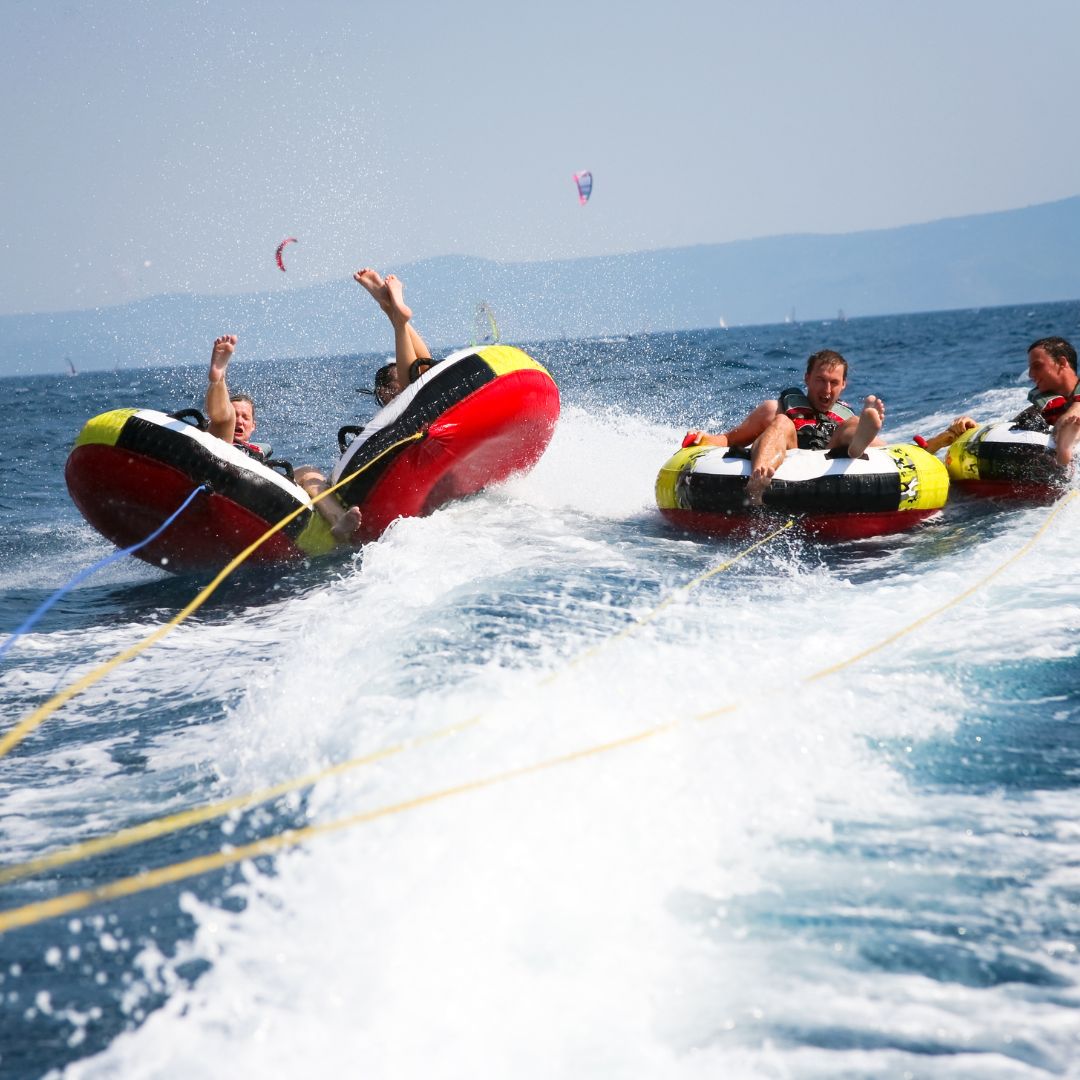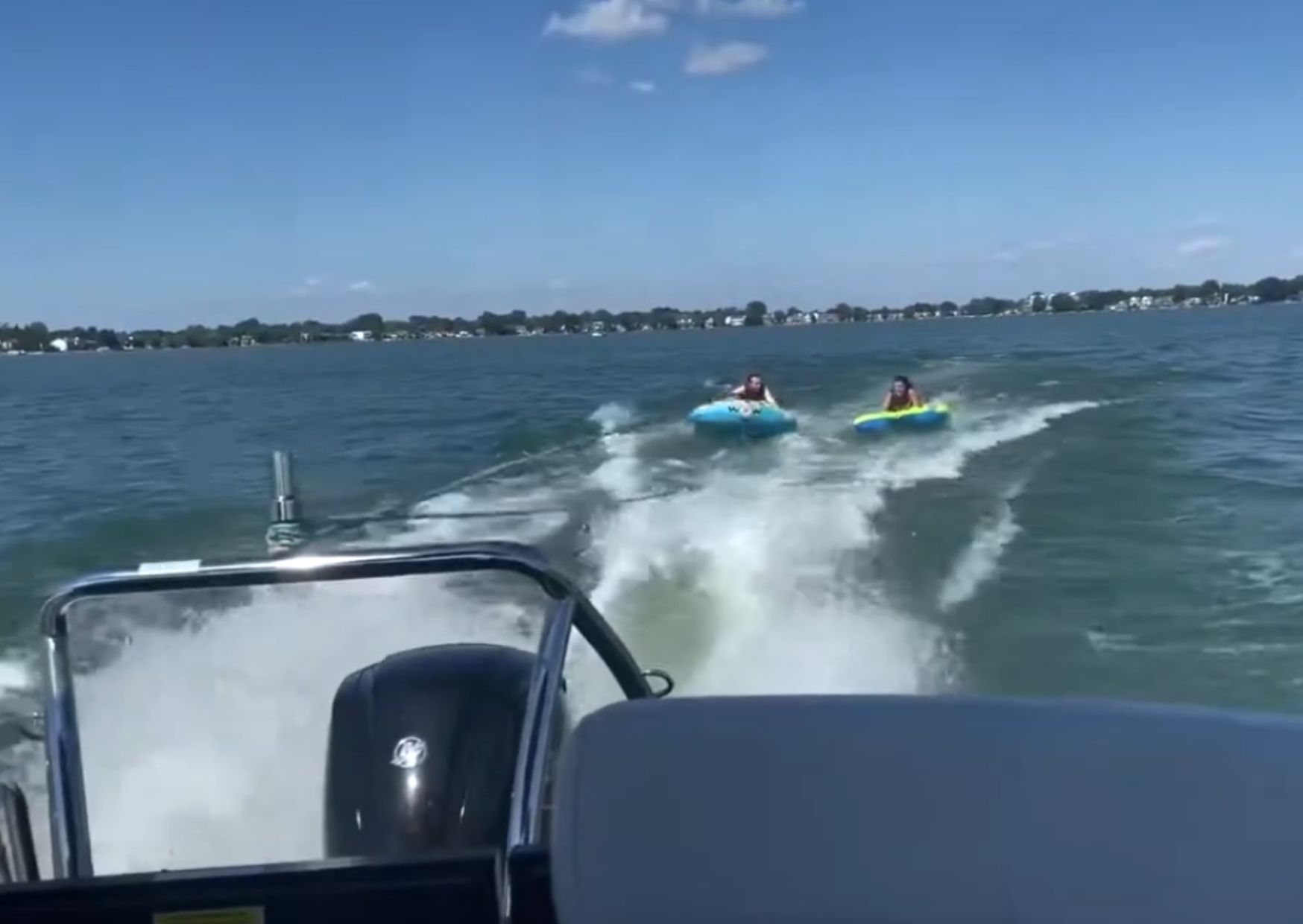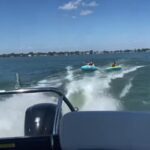Thrilling Tubing Behind Boat – Unleash the Thrill of Tubing Behind a Boat
Tubing behind boats is a fun and exhilarating water sport that can be enjoyed by people of all ages. Imagine being pulled through the water at high speeds, feeling the wind in your hair and the sun on your face. It’s an amazing feeling, and it’s one that you’ll never forget.
Did you know that tubing behind a boat is not just about skimming across the water? It’s a gravity-defying dance with the waves that’ll leave you grinning from ear to ear! Picture yourself soaring through the air, laughing with delight as you try to hold on for dear life.
In this blog post, we’ll discuss everything you need to know about tubing behind a boat. We’ll cover topics such as how to choose the right tube, how to stay safe, and where to go tubing. So whether you’re a beginner or a seasoned pro, this blog post is for you.
What Is Tubing Behind Boat
Tubing behind boats refer to the recreational activity of being towed on an inflatable tube or watercraft while being pulled by a motorized boat. It is a popular water sport that offers exhilarating and fun-filled experiences for you and families alike. In fact you can pull two tubes behind a boat for more fun.
Participants sit, lie, or kneel on the tube, holding on to handles or ropes, as they glide across the water’s surface. The boat’s speed and movements create waves and turns, adding excitement and a sense of adventure to the experience.
Tubing behind boats provide a thrilling ride that can be enjoyed by people of various ages and skill levels, making it a fantastic way to enjoy the water and create lasting memories.
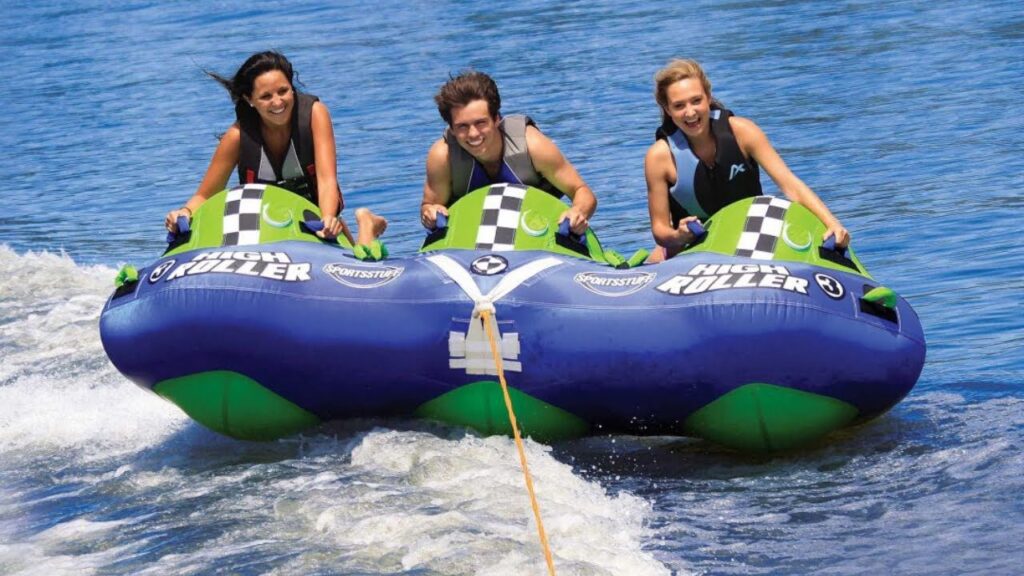
Benefits of Tubing Behind Boat
Tubing behind boats offer a range of benefits, making it a popular recreational activity for water sports enthusiasts. Here are some key advantages of tubing behind boats:
1. Thrilling and Fun-Filled Experience
Tubing provides an adrenaline rush and a sense of excitement as you glide across the water’s surface, catching waves and experiencing the boat’s movements. It offers a unique combination of speed, twists, and turns, making it an exciting activity for you.
2. Accessibility for All Ages and Skill Levels
Tubing behind a boat can be enjoyed by people of different ages and skill levels. Whether you’re a beginner or an experienced water sports enthusiast, tubing provides a thrilling ride that can be easily adjusted based on the rider’s preferences and abilities.
3. Social and Bonding Activity
Tubing behind boat is often enjoyed with family and friends, providing an opportunity for shared experiences and quality time together. It allows participants to bond, laugh, and create lasting memories while enjoying the water and the thrill of the ride.
4. Low Barrier to Entry
Unlike some other water sports activities, tubing behind a boat has a relatively low barrier to entry. The equipment required is minimal and easily accessible, typically consisting of an inflatable tube, tow rope, and life jacket.
This makes it a convenient and cost-effective option for individuals or families looking to engage in water-based fun.
5. Enjoyment of Nature and Water
Tubing behind a boat allows participants to immerse themselves in the natural beauty of lakes, rivers, or coastal areas. It provides an opportunity to enjoy the refreshing water, scenic surroundings, and the freedom of being out on the open water.
6. Physical and Mental Benefits
Tubing engages various muscles in the body, providing a low-impact workout. It can improve core strength, balance, and coordination. Additionally, the exhilaration and enjoyment of tubing can have positive effects on mental well-being, reducing stress and boosting mood.
7. Variety and Versatility
Tubing offers a wide range of experiences and options. There are different types of tubes available, including single-rider tubes, multi-rider tubes, and specialty tubes designed for tricks and jumps.
Additionally, tubing can be customized based on the boat’s speed, the intensity of maneuvers, and the preferences of the participants, allowing for a diverse and dynamic experience.
Overall, tubing behind a boat combines the thrill of speed and water with social interaction, making it a popular and enjoyable activity for you and families seeking adventure and fun on the water.
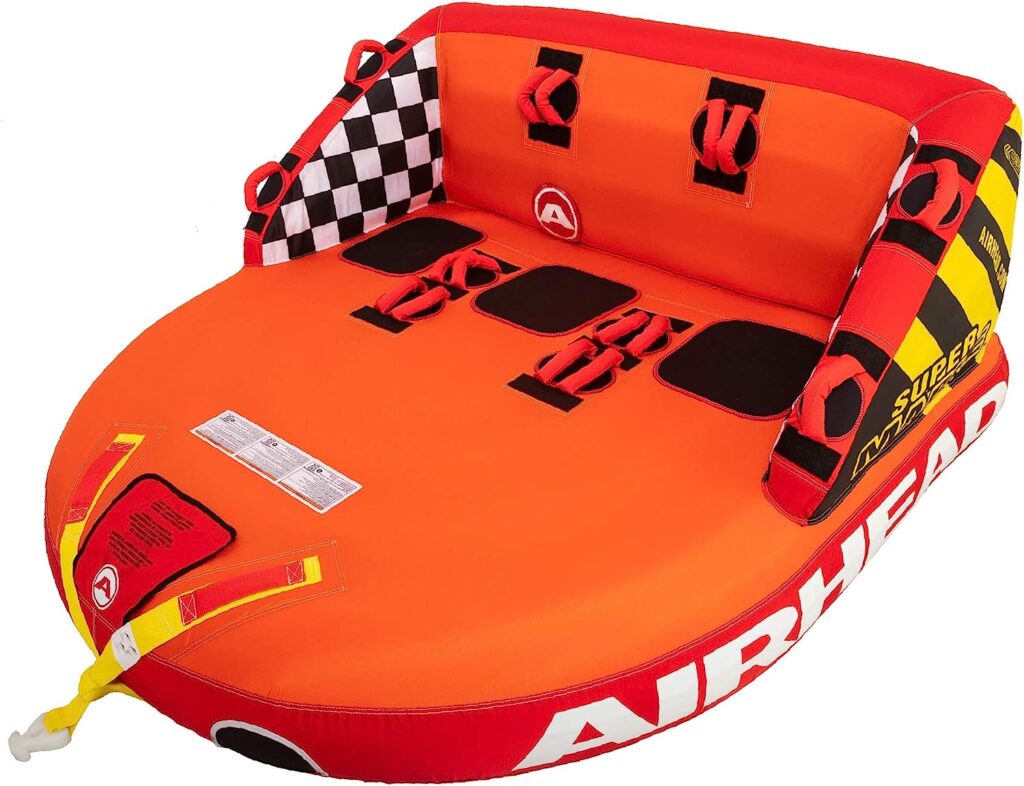
How To Choose The Right Tube
Choosing the right tube is essential to ensure a safe and enjoyable tubing experience. Here are some factors to consider when selecting a tube:
1. Rider’s Weight and Size: Consider the weight and size of the rider or riders who will be using the tube. Tubes typically have weight and size recommendations provided by the manufacturer. Ensure that the chosen tube can accommodate the weight of the rider(s) and provides a comfortable fit.
2. Capacity and Number of Riders: Determine the number of riders who will be using the tube simultaneously.
Tubes come in various capacities, ranging from single-rider tubes to multi-rider tubes that can accommodate two or more riders. Ensure the tube’s capacity aligns with the number of participants.
3. Riding Style and Preferences: Consider the riding style and preferences of the riders. Some tubes are designed for a more relaxed ride, while others are built for higher speeds and more adventurous maneuvers.
Determine whether the riders prefer a laid-back experience or if they want to perform tricks and jumps.
4. Boat Compatibility: Consider the type of boat that will be towing the tube. Different boats may have different towing capabilities and tow points. Ensure the tube you choose is compatible with the boat and can be safely towed without interfering with the boat’s performance.
5. Water Conditions: Consider the type of water conditions where the tubing will take place. If you’ll be tubing on calm lakes or rivers, a standard tube may suffice. However, if you’ll be tubing in more challenging conditions or on ocean waves, you may want to consider a tube designed for rougher water.
6. Durability and Material: Check the durability and material quality of the tube. Look for tubes made from durable materials that can withstand the rigors of towing and potential abrasions. Reinforced bottoms and sturdy construction can enhance the tube’s longevity.
7. Safety Features: Ensure the tube has safety features, such as secure handles or grips for riders to hold on to. These features can provide stability and help you maintain grip during the ride.
8. Budget Considerations: Set a budget for your tube purchase. Tubes are available at various price points, so consider your budget while balancing the desired features, quality, and durability.
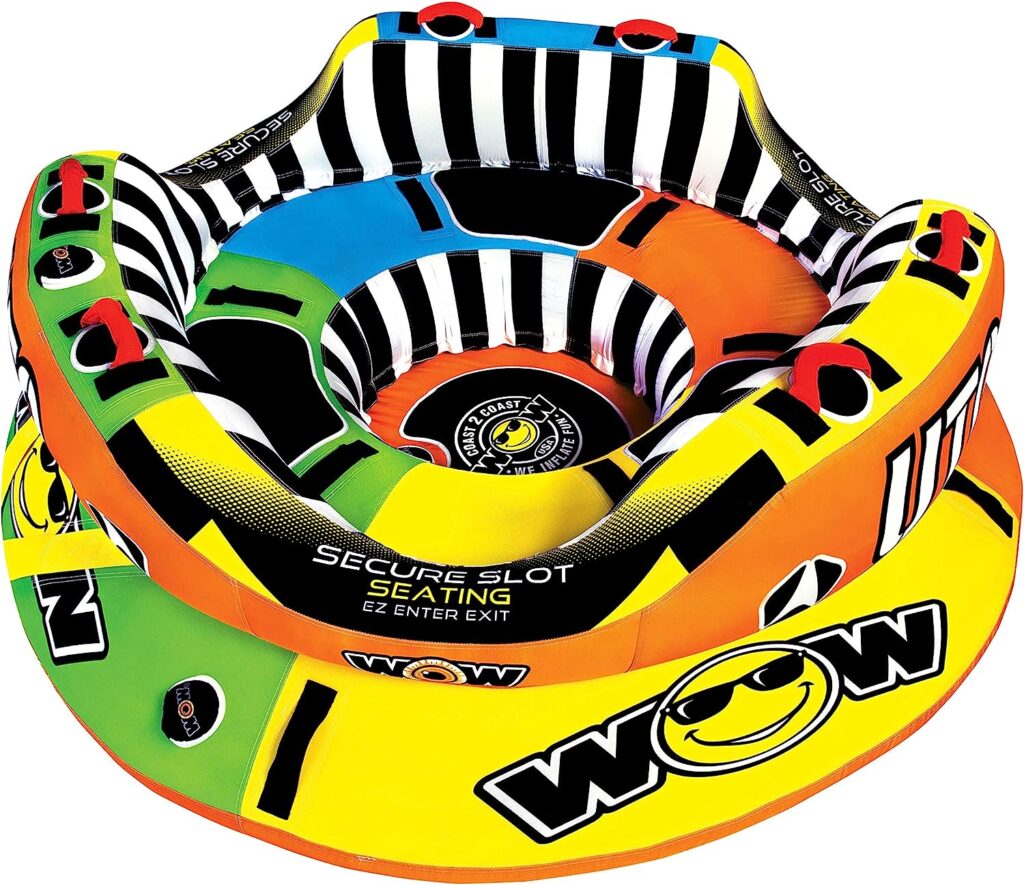
Essential Equipment And Gears Required For Tubing Behind Boat
When it comes to tubing behind a boat, having the right equipment is essential to ensure a safe and enjoyable experience on the water. Let’s take a closer look at the essential gear you’ll need to get started.
1. Inflatable Tubes
The centerpiece of the activity, inflatable tubes come in various shapes, sizes, and designs. Some popular options include donut-shaped tubes, deck-style tubes, or multi-rider tubes.
Consider factors such as the number of riders, comfort features like backrests or handles, and durability when choosing a tube. Look for high-quality materials that can withstand the rigors of towing and provide a smooth ride.
2. Tow Ropes
A strong and durable tow rope is necessary to connect the tube to the boat. Opt for ropes specifically designed for tubing, as they are typically thicker and more resistant to wear and tear.
Look for ropes with sufficient length, usually around 50 to 65 feet, to provide ample distance between the boat and the tube.
3. Life Jackets
Safety should always be a top priority when engaging in water sports. Ensure that each participant wears a properly fitting and Coast Guard-approved life jacket. Choose life jackets designed for water activities to provide buoyancy and protection in case of falls or unexpected situations.
4. Boat Specifications
The boat used for tubing should have sufficient power and stability to tow the tube safely. A boat with a horsepower of at least 40-75 is generally recommended, depending on the weight and number of riders. Make sure the boat is in good working condition, with a sturdy tow point and a reliable engine.
5. Air Pump
Inflating the tube before each use is necessary. An electric or manual air pump can make this process easier and more convenient. Check if the tube you choose requires a specific type of pump and ensure you have it on hand.
When selecting equipment, consider the number of riders, their ages, and skill levels. Some tubes are designed for a single rider, while others can accommodate multiple riders.
Additionally, certain tubes may offer extra features like handles for better grip, reinforced bottoms for durability, or even built-in cup holders for added convenience.
Remember to inspect all equipment regularly for signs of wear and tear and replace or repair as needed. Prioritize safety, comfort, and durability when choosing your tubing gear. With the right equipment, you’ll be all set for an exciting and enjoyable tubing adventure on the water!
READ ALSO: Is Snow Tubing Dangerous? – Uncover The Secrets To Safe And Thrilling Tubing Adventure
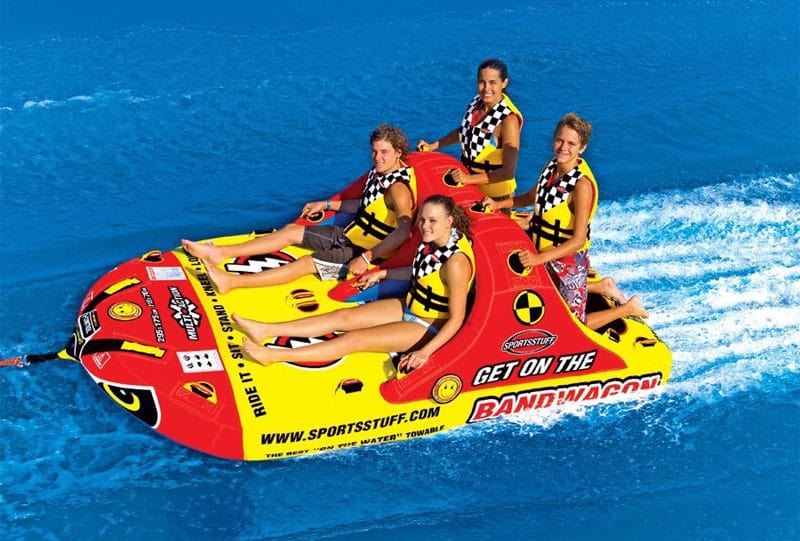
Step-By-Step Instructions On How To Prepare For Tubing
Getting started with tubing behind a boat is an exciting process that involves a few key steps to ensure a smooth and enjoyable experience. Here’s a step-by-step guide to help you prepare for your tubing adventure:
1. Launching the Boat
- Ensure your boat is in good working condition, including the engine, steering, and safety equipment.
- Back the boat into the water at a designated boat ramp or launch area.
- Once the boat is in the water, park your vehicle and trailer in a designated area.
- Start the boat’s engine and let it warm up while performing necessary safety checks, such as verifying fuel levels and checking the navigation lights.
2. Inflating the Tube
- Choose a suitable area away from the water’s edge to inflate the tube.
- Using an air pump compatible with your tube, inflate it to the recommended pressure level specified by the manufacturer.
- Ensure all valves are securely closed, and the tube is fully inflated without any leaks or punctures.
3. Securing the Tow Rope
- Attach the tow rope to the boat’s tow point, usually a sturdy, dedicated cleat or hook designed for towing.
- Ensure the tow rope is properly secured, with no knots or tangles.
- Double-check the connection to ensure it is strong and won’t come loose during the ride.
4. Positioning on the Tube
- Sit on the tube and position yourself centrally, distributing your weight evenly.
- Hold onto the handles or grips provided on the tube, ensuring a firm grip.
- Place your feet or knees securely in the designated areas of the tube, if applicable.
5. Maintaining Balance and Riding Technique
- Keep your knees slightly bent and your body relaxed while on the tube.
- Lean back and maintain a low center of gravity to enhance stability and balance.
- As the boat starts moving, lean into turns to counterbalance the centrifugal force and maintain control.
- Use your core muscles to stabilize your body and absorb the bumps or waves encountered during the ride.
- Enjoy the ride and communicate with the spotter and boat driver using pre-established hand signals.
With these step-by-step instructions, you’ll be ready to hit the water, enjoy the thrill of tubing, and create lasting memories. Have a fantastic time!
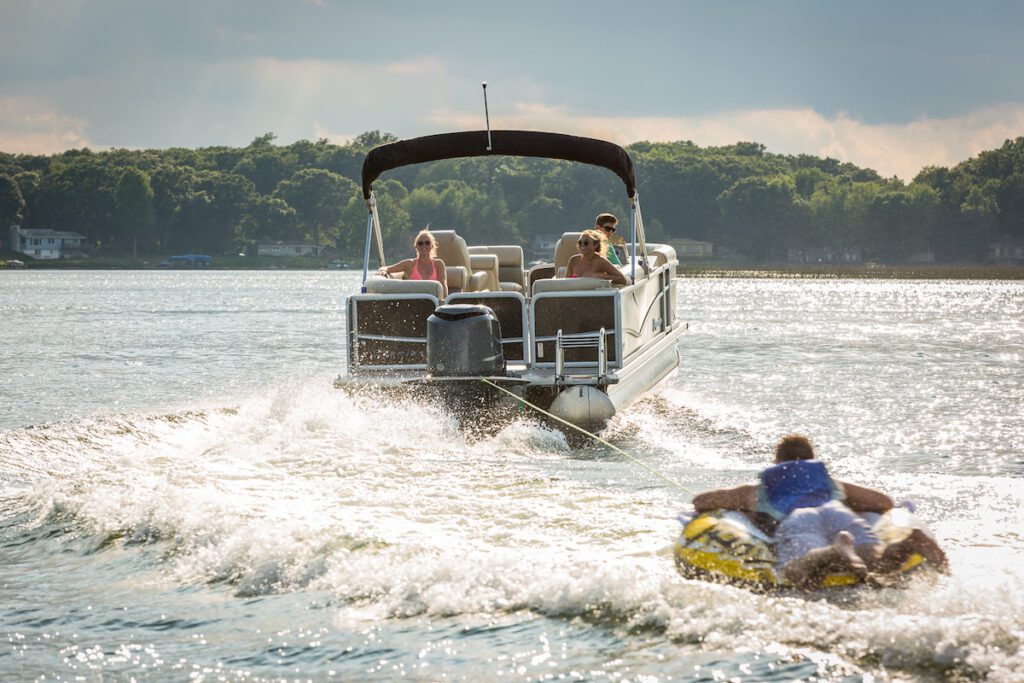
Riding Techniques And Tricks For Tubing Behind Boat
Riding a tube behind a boat is not only about holding on and enjoying the ride—it also offers opportunities for various riding techniques and tricks.
Whether you’re a beginner looking to build confidence or an experienced rider seeking to take it to the next level, here are some tips and techniques to enhance your tubing experience:
1. Basic Riding Positions
- Sit-On-Top: This is the most common and stable riding position. Sit on the tube, keeping your feet or knees securely inside the tube’s designated areas.
- Lying Down: For a more relaxed ride, lie down on your stomach, extending your arms forward and gripping the handles. This position allows you to feel closer to the water.
2. Turning and Maneuvering Techniques
- Leaning: To steer the tube, lean your body weight in the direction you want to turn. Leaning into a turn helps shift the tube’s center of gravity, facilitating smoother turns.
- Weight Transfer: Experiment with shifting your weight from side to side or front to back. This technique can help you navigate around waves or obstacles and maintain balance during turns.
3. Building Confidence for Beginners
- Start Slow: Begin with slower speeds to build confidence and become comfortable with the ride. Gradually increase the speed as you feel more at ease.
- Hold On Firmly: Grip the handles firmly to maintain a secure hold on the tube. Relax your arms and upper body to absorb bumps or waves.
4. Tricks for Advanced Riders
- Jumping the Wake: As you become more experienced, try timing your jumps to catch air off the boat’s wake. Coordinate your leap with the boat’s movements for an exciting thrill.
- 360 Spins: Once you have mastered the basics, attempt a 360-degree spin on the tube. Shift your weight and use your core muscles to initiate the rotation.
5. Communication with the Boat Driver
Establish hand signals or verbal cues with the spotter and boat driver to communicate your desired speed, changes in direction, or any adjustments needed during the ride.
6. Safety Reminders
- Always wear a properly fitted life jacket.
- Be aware of your surroundings and potential hazards.
- Maintain a safe distance from other boats, swimmers, and obstacles.
- Avoid sudden or erratic movements that could jeopardize your safety or that of others.
Remember, practice and experience will help you improve your riding skills and try more advanced tricks. Start with the basics, gradually progress, and always prioritize safety. Enjoy the thrill of tubing and have a blast on the water!
RELATED: Do Water Shoes Protect Against Stingrays
Choosing The Right Location For Tubing Behind Boat
When it comes to tubing behind a boat, choosing the right location plays a crucial role in the overall experience. Different water bodies offer varying conditions and considerations. Here are some factors to consider when selecting a location for tubing behind boat:
1. Lakes
Lakes are popular choices for tubing due to their calm waters and ample space. They provide a relatively controlled environment for tubing, making it easier to maintain a consistent speed and ride. Ensure the lake allows boating activities and check for any specific restrictions or guidelines set by local authorities.
2. Rivers
Tubing behind boat on rivers can provide an exciting and adventurous experience. However, it’s important to consider the river’s flow rate, rapids, and water levels.
Choose sections of the river that have a moderate flow and are suitable for tubing. Be aware of any potential hazards like rocks, fallen trees, or strong currents.
3. Coastal Areas
Tubing in coastal areas can offer a unique experience with ocean waves. However, it’s essential to choose areas that are suitable for boating and tubing.
Coastal waters can be unpredictable, so ensure you are familiar with local regulations, tides, and currents. Consider factors such as wave height, offshore winds, and weather conditions.
4. Water Conditions
Evaluate the water conditions of your chosen location. Look for clear water with good visibility to ensure the safety of all participants. Consider the presence of underwater obstacles or hazards that may pose a risk during the ride.
5. Legal Restrictions
Check local regulations and laws regarding boating and tubing activities in the area. Some lakes, rivers, or coastal regions may have specific rules or restrictions for boating, speed limits, or designated areas for water sports. Ensure you comply with all relevant regulations to avoid any legal issues.
6. Public Access
Determine if the location offers public access or if you need to seek permission or pay fees for using the water body. Research public boat ramps, launch points, or designated areas for tubing. Ensure you have proper access and parking facilities for your boat and trailer.
7. Amenities and Facilities
Consider the availability of amenities such as restroom facilities, picnic areas, or nearby parking. These amenities can enhance the overall experience and make it more convenient for you and your group.
8. Local Knowledge and Recommendations
Reach out to locals, water sports enthusiasts, or local boating associations to get insights and recommendations on the best locations for tubing in the area. They can provide valuable information about hidden gems or lesser-known spots that offer ideal conditions for tubing.
Safety Guidelines
Safety is paramount when it comes to tubing behind a boat. To ensure a safe and enjoyable experience for everyone involved, it’s crucial to follow some essential guidelines. Here are some key tips to keep in mind:
1. Wear Properly Fitted Life Jackets: Always wear Coast Guard-approved life jackets while tubing. Ensure that each participant wears a life jacket that fits snugly and provides proper buoyancy. Life jackets should be fastened securely and not be too loose or restrictive.
2. Be Mindful of Speed: Keep the speed at a safe and comfortable level for all riders. Avoid excessive speeds that may cause loss of control or result in rough landings. The recommended speed for tubing is typically around 15-25 mph, but this may vary based on the riders’ skill levels and comfort.
3. Assign a Spotter: It is essential to have a designated spotter on the boat. The spotter’s primary responsibility is to keep a constant eye on the riders and communicate with the boat driver.
They should alert the driver of any potential hazards or signals from the tubers, ensuring everyone’s safety throughout the ride.
4. Communicate Hand Signals: Establish a set of hand signals between the spotter and the riders to communicate effectively during the tubing session.
Signals can indicate the desired speed, whether to speed up or slow down, or to stop the ride altogether. Clear and agreed-upon signals help maintain a smooth and controlled experience.
5. Stay Clear of Hazards: Before starting the tubing adventure, survey the area for any potential hazards, such as rocks, shallow water, or other boats. Maintain a safe distance from docks, shorelines, and swimming areas. Be cautious of other watercraft and give them a wide berth.
6. Be Mindful of Weather Conditions: Keep an eye on the weather forecast and avoid tubing in adverse conditions such as high winds, storms, or choppy waters.
Weather conditions can significantly affect water safety, so prioritize the well-being of all participants by choosing suitable weather conditions for tubing.
7. Educate Participants on Safe Landing: Instruct riders on how to land safely if they fall off the tube. Encourage them to let go of the tow rope and cover their faces with their hands while landing in the water to prevent injury.
Remind them to always resurface away from the boat to avoid potential accidents.
8. Know Your Limits: Assess the abilities and comfort levels of all participants. Tailor the ride to the least experienced rider in the group and ensure that everyone is comfortable with the speed and intensity of the tubing session.
Encourage participants to speak up if they feel uncomfortable or unsafe during the ride.
By adhering to these safety guidelines, you can minimize the risk of accidents and ensure a safe and enjoyable tubing experience for everyone involved. Remember, safety should always be the top priority to make lasting memories on the water.
RELATED: Do Water Shoes Protect Against Sea Urchins
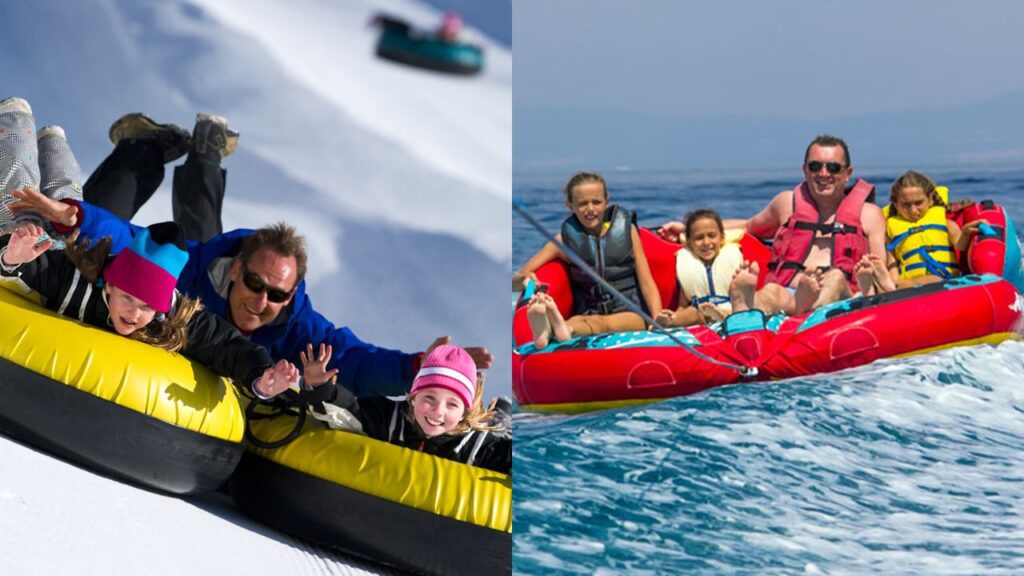
Family-Friendly Tubing: The Suitability Of Tubing As A Family Activity
Tubing behind a boat is an excellent family-friendly activity that can create lasting memories and foster a sense of togetherness. Here are some reasons why tubing is suitable for families and suggestions for involving children of different ages:
1. Inclusive for All Ages
Tubing can be enjoyed by family members of various ages, from young children to teenagers and adults. It offers a thrilling experience that can be tailored to suit different comfort levels and skill levels.
2. Shared Excitement
Tubing allows family members to share in the excitement and joy of the ride together. It encourages bonding, laughter, and creates opportunities for shared experiences that will be cherished for years to come.
3. Safety Considerations for Young Children
- Life Jackets: Ensure that all children wear properly fitted life jackets at all times while tubing. Choose child-sized life jackets approved for their weight and size.
- Towing Speed: Keep the speed at a comfortable and safe level, especially for young children. Slow speeds will allow them to enjoy the ride without feeling overwhelmed.
- Tube Selection: Choose a tube appropriate for young children, such as a multi-rider tube or a tube with a more stable and secure seating area.
- Close Supervision: Assign an adult or responsible older sibling as a dedicated spotter for young children. They should provide constant supervision and communicate with the boat driver.
4. Gradual Progression
Start with gentle rides and gradually increase the speed and intensity as children become more comfortable and confident. Encourage them to progress at their own pace, ensuring their enjoyment and safety.
5. Communication and Instruction
Clearly communicate instructions to children regarding safety guidelines, hand signals, and how to hold on securely to the handles. Teach them to relax and enjoy the ride while maintaining an awareness of their surroundings.
6. Snack and Breaks
Consider taking breaks during the tubing session to provide children with rest and hydration. Pack some snacks and water on the boat to keep their energy levels up and make the experience more enjoyable.
7. Positive Reinforcement
Encourage and praise children for their efforts and achievements, whether it’s successfully holding on, trying new positions, or simply having fun. Positive reinforcement will boost their confidence and enhance their overall experience.
8. Be Mindful of Sun Protection
Ensure that everyone, especially young children, is adequately protected from the sun. Apply sunscreen before going out on the water and consider providing sun hats, sunglasses, and UV-protective clothing.
Tips For Maintenance and Storage Of Tubes
Proper maintenance and storage of your tubing equipment are essential for ensuring its durability and longevity. Here are some guidelines and tips to help you take care of your tubing gear:
1. Cleaning the Tube
- Rinse with Fresh Water: After each use, thoroughly rinse the tube with fresh water to remove salt, sand, or debris that may have accumulated during the ride.
- Mild Soap Solution: For more thorough cleaning, use a mild soap solution and a soft brush or cloth to scrub the tube gently. Avoid harsh chemicals or abrasive cleaners that could damage the material.
- Dry Completely: Allow the tube to air dry completely before storing. Ensure there is no moisture remaining, as it can lead to mold or mildew growth.
2. Inflating and Deflating
- Inflate Properly: Follow the manufacturer’s recommendations regarding the correct inflation pressure for your tube. Overinflating or underinflating the tube can affect its performance and durability.
- Avoid Overexposure to Heat: During storage or transportation, avoid leaving the tube in direct sunlight or extreme heat for prolonged periods, as it can cause damage to the material.
- Deflate Carefully: When deflating the tube, open all valves and allow the air to escape slowly. This prevents sudden pressure changes that could damage the tube.
3. Storing the Tube
- Dry Thoroughly: Before storing, ensure the tube is completely dry to prevent mold or mildew growth. Wipe it down if necessary.
- Remove Accessories: Detach any additional accessories, such as tow ropes or handles, before storing them separately.
- Proper Storage Space: Store the tube in a cool, dry place away from direct sunlight, moisture, and extreme temperatures. Hanging it or placing it in a well-ventilated storage bag is ideal.
4. Maintaining Tow Ropes and Accessories
- Inspect Regularly: Check the tow ropes, handles, and other accessories for signs of wear and tear. Replace any frayed ropes or damaged parts promptly to ensure safety.
- Store Properly: Coil the tow rope neatly and store it in a dry place to prevent tangling or damage.
- Check Connections: Before each use, verify that all connections between the tube and the tow rope are secure and properly fastened.
5. Regular Inspections
- Check for Leaks: Periodically inspect the tube for any signs of leaks, such as hissing sounds or deflation. If you suspect a leak, conduct a thorough inspection to locate and repair it using appropriate patching materials or repair kits.
- Assess Wear and Tear: Examine the tube for any signs of wear, such as abrasions, punctures, or weak spots. Address any issues promptly to prevent further damage.
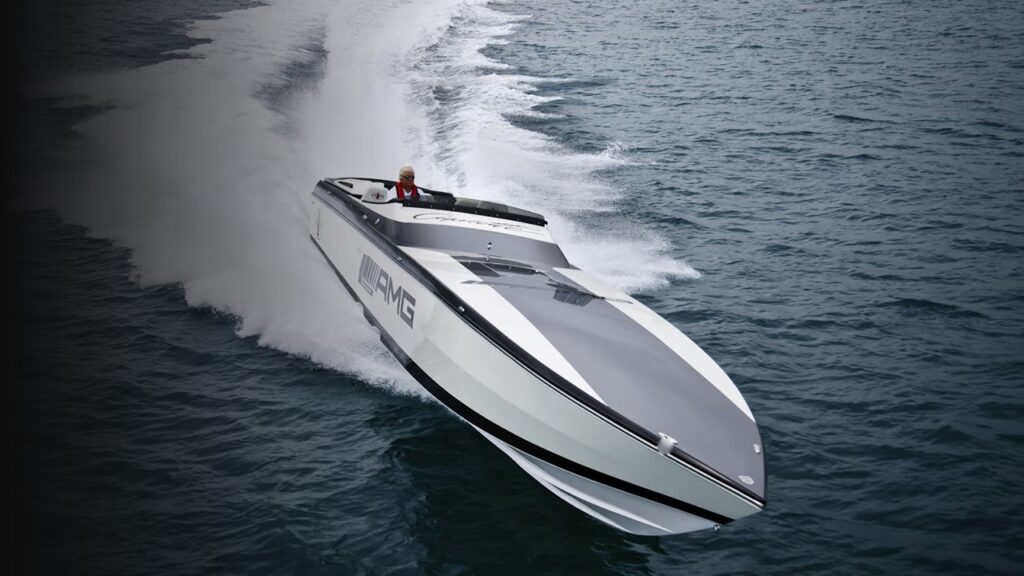
Best Boats For Tubing Behind Boat
Selecting the right boat for tubing is crucial to ensure a safe and enjoyable experience for both the tubers and the boat’s occupants. Here are some types of boats commonly used for tubing, along with key features to consider when choosing a boat for tubing purposes:
1. Speedboats
– Speedboats are a popular choice for tubing due to their power, maneuverability, and ability to generate substantial speed.
– Look for a speedboat with a strong engine, preferably in the range of 40-75 horsepower or more, depending on the weight and number of riders.
– Ensure the boat has a sturdy tow point designed for towing water sports activities and a reliable steering system for better control.
2. Pontoon Boats
– Pontoon boats provide a stable and comfortable platform for tubing, making them an excellent choice for families or those seeking a more relaxed tubing experience.
– Look for pontoon boats with sufficient horsepower to generate the desired speed for tubing.
– Consider the layout and seating configuration to accommodate the number of tubers and observers comfortably.
– Ensure the pontoon boat has a strong and secure tow bar or attachment point for towing tubes.
3. Personal Watercraft (PWC)
– Personal watercraft, commonly known as jet skis, can also be used for tubing.
– Look for a PWC with a high-powered engine that can tow tubes safely. Check the manufacturer’s specifications for the recommended maximum towing capacity.
– Ensure the PWC has a secure and durable tow point or towing attachment specifically designed for water sports activities.
Key Features to Consider for Tubing Boat
– Tow Point: The boat should have a dedicated tow point that is strong, secure, and designed for towing tubes. It should be positioned to minimize rope interference with the boat and provide an optimal towing angle.
– Power and Speed: Consider the boat’s horsepower and performance capabilities to ensure it can generate sufficient speed for tubing while maintaining stability and control.
– Seating and Capacity: Evaluate the seating capacity of the boat to accommodate both tubers and observers comfortably. Sufficient seating and proper weight distribution are essential for a balanced ride.
– Stability and Maneuverability: Look for a boat with good stability to handle the weight distribution during tubing. Maneuverability is also important for making turns and avoiding obstacles.
– Safety Features: Ensure the boat is equipped with essential safety features, such as navigation lights, life jackets, and a functioning fire extinguisher.
Before purchasing or renting a boat for tubing, it’s recommended to consult with a knowledgeable boat dealer. They can provide guidance based on your specific needs, preferences, and budget to help you find the best boat for tubing that suits your requirements.
Boat Tubing Near Me – Popular Tubing Destinations And Event
If you’re looking for popular tubing destinations or events worldwide, there are numerous locations that attract tubing enthusiasts. Here are some well-known tubing spots and events that offer thrilling experiences and opportunities for water sport enthusiasts:
1. Comal River (Texas, USA)
Located in New Braunfels, Texas, the Comal River is a popular tubing destination known for its crystal-clear waters and scenic surroundings. It offers a relaxing tubing experience, with tube rentals and shuttle services available.
2. Vang Vieng (Laos)
Vang Vieng in Laos is famous for its tubing scene along the Nam Song River. Tubing here involves floating downstream, passing lush landscapes, limestone cliffs, and stopping at riverside bars and cafes for refreshments.
3. Salt River Tubing (Arizona, USA)
Located near Phoenix, Arizona, Salt River Tubing offers a fun-filled tubing experience on the Salt River. With stunning desert landscapes and gentle currents, it’s a popular destination for tubing enthusiasts of all ages.
4. Guadalupe River (Texas, USA)
The Guadalupe River in Texas provides an exciting tubing experience, particularly in the stretch between New Braunfels and Canyon Lake. It offers both leisurely floats and adrenaline-pumping rapids for tubing enthusiasts.
5. Ichetucknee Springs State Park (Florida, USA)
Ichetucknee Springs State Park in Florida is known for its picturesque Ichetucknee River, offering refreshing tubing adventures through pristine waters surrounded by lush vegetation and wildlife.
6. Chattahoochee River (Georgia, USA)
The Chattahoochee River in Georgia is a popular tubing destination, especially in the Helen area. Tubers can enjoy the beautiful scenery and relax while floating downstream.
7. Takhini River Hot Springs (Yukon, Canada)
Takhini River Hot Springs in the Yukon, Canada, offers a unique tubing experience with the combination of natural hot springs and river floating. It’s a perfect blend of relaxation and adventure.
8. Schlitterbahn Waterpark (Texas, USA)
Schlitterbahn Waterpark in New Braunfels, Texas, hosts the World’s Longest Waterpark Tube Chute, providing an exhilarating tubing experience as you slide down a massive waterslide.
9. Annual Tubing Events
Various annual tubing events and festivals take place worldwide, attracting tubing enthusiasts. Examples include the Ginnie Springs Outdoors Fest in Florida, USA (https://ginniespringsoutdoors.com/activities-rentals) and the River Rats Festival in New Zealand (https://www.riverratsfestival.com/).
When planning a tubing adventure, it’s always recommended to check local regulations, safety guidelines, and weather conditions. Additionally, keep in mind that popularity and events may vary from year to year, so it’s essential to research the most up-to-date information.
Explore these renowned tubing destinations and consider attending events to join like-minded enthusiasts, celebrate the thrill of tubing, and create unforgettable experiences on the water.
How Far Should A Tube Be Behind A Boat
The distance between the tube and the boat, known as the tow length, is an important consideration for a safe and enjoyable tubing experience. The general guideline is to maintain a tow length of approximately 100 feet (30 meters) behind the boat.
However, the specific tow length may vary depending on factors such as boat speed, water conditions, rider skill levels, and local regulations.
Here are a few factors to consider when determining the appropriate tow length:
1. Boat Speed: The speed at which the boat is traveling plays a significant role in determining the ideal tow lengths. Adjust the tow length to maintain a safe and comfortable speed for the riders.
Generally, a speed of around 15-25 mph (24-40 km/h) is recommended for tubing, but it may vary depending on the riders’ preferences and skill levels.
2. Water Conditions: Consider the water conditions, including wave size, wind, and current strength. Choppier or rougher waters may require a shorter tow length to ensure stability and control. Adjust the tow length accordingly to provide a smoother and more enjoyable ride.
3. Rider Skill Levels: The skill levels and comfort of the riders should be taken into account when determining the tow length. Less experienced riders may prefer a shorter tow length to feel more secure, while more advanced riders may be comfortable with a longer tow length for a greater challenge.
4. Local Regulations: Be aware of any specific local regulations or guidelines regarding tow lengths for tubing. Some areas or water bodies may have specific restrictions or recommendations in place to ensure safety and minimize interference with other watercraft.
Always prioritize safety and maintain clear communication between the spotter, riders, and boat driver. Ensure there is sufficient distance to avoid any potential collisions or accidents.
Adjust the tow length as needed to accommodate varying factors and ensure a safe and enjoyable tubing experience for everyone involved.
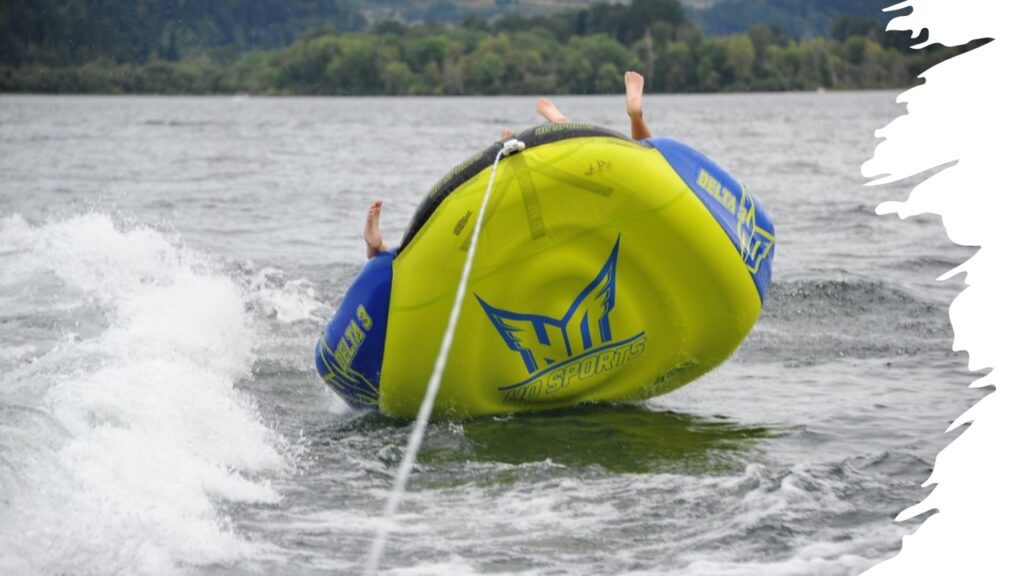
Dangers Of Tubing Behind A Boat
While tubing behind a boat can provide a thrilling and enjoyable experience, it’s important to be aware of the potential dangers involved. Here are some risks to consider:
1. Falls and Injuries: Riders may fall off the tube, especially when navigating waves or sharp turns. Falls can lead to injuries, such as bruises, cuts, or more serious injuries like sprains or fractures.
2. Collision Hazards: Tubing in crowded or busy waterways increases the risk of collisions with other boats, swimmers, or stationary objects like docks or buoys. It’s crucial to maintain situational awareness and keep a safe distance from potential hazards.
3. Water Depth and Obstacles: Tubing in shallow waters or areas with submerged objects, rocks, or logs poses a risk of impact. It’s important to choose tubing locations carefully and be mindful of water depth and potential hazards beneath the surface.
4. Speed and Maneuvering: High speeds and sharp maneuvers can increase the risk of losing control or being thrown off the tube. It’s important to ensure that the speed and maneuvers are suitable for the riders’ skill levels and comfort.
5. Water Conditions: Changing water conditions, such as strong currents, rough waves, or unexpected weather, can pose additional dangers. Always monitor weather forecasts and water conditions before tubing and adjust plans accordingly.
6. Rope Entanglement: The tow rope used for tubing can present a risk of entanglement. Riders should be cautious of the rope and avoid putting body parts near it to prevent potential injuries.
7. Sun and Heat Exposure: Spending extended periods under the sun while tubing can lead to sunburn, dehydration, and heat-related illnesses. It’s important to stay hydrated, wear appropriate sun protection, and take breaks in shaded areas.
To mitigate these risks, it’s crucial to prioritize safety by following these guidelines:
– Always wear properly fitted and Coast Guard-approved life jackets.
– Choose appropriate tubing locations with ample space and minimal hazards.
– Follow boating and water safety regulations and guidelines.
– Communicate with the boat driver and spotter using pre-established signals.
– Maintain a safe speed and avoid reckless maneuvers.
– Be mindful of other boaters, swimmers, and potential hazards in the water.
– Regularly inspect and maintain tubing equipment for optimal performance.
By being aware of the potential dangers and taking appropriate safety measures, you can minimize risks and enjoy a safe and thrilling tubing experience behind a boat.
The Bottom Line On Tubing Behind Boat
Tubing behind boats offer an exhilarating and unforgettable experience on the water. Whether you’re seeking ecstasies, family bonding, or simply a fun-filled adventure, tubing behind a boat delivers.
By selecting the right tube, considering rider preferences and boat compatibility, and ensuring safety measures, you can dive into the excitement of tubing behind a boat.
So, gear up, hold on tight, and get ready to create memories that will last a lifetime with tubing behind a boat. Start your thrilling journey today!
